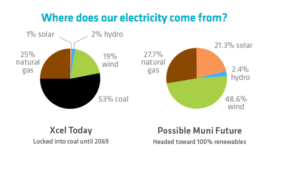Colorado is on pace to meet the carbon pollution goals under the Environmental Clean Power Plan. Despite President Trumps order eliminating many restrictions on fossil fuel production; Governor Hickenlooper announced Colorado will move forward with clean energy initiatives. Colorado is the seventh largest energy producing state in the United States. Our state has tougher rules and regulations than the federal government for finding and fixing leaks from oil and gas wells, tanks and pipelines.
Wind and solar energy are about to become unstoppable. Natural gas and oil production are approaching their peak. In 2017 clean energy installations broke new records worldwide. Wind and solar energy are seeing twice as much funding as fossil fuels. For the first time ever, the United States has over 100,000 people employed in the wind industry. Clean energy grew at a record pace in 2017. Can you guess the fastest growing occupation in the United States? The industry progressed so rapidly it wasn’t even close: Wind Technician. The United States added 22 Gigawatts capacity in clean energy, which is equal to 11 Hoover Damns. Coal fired power plants now provide only 30% of the country’s electricity; compared to 50% in 2008. Recently Colorado shut down the coal train going to the Xcel Energy Valmont Plant. Platte River Power Rawhide Station is the only coal burning power plant in the state. Colorado is ranked in the top 10 for wind production due to these changes.
It has been long debated if economic growth can be achieved while moving away from fossil fuels. Electricity costs have fallen more than 2% and Americans spent less than 4% of their household costs on energy for the first time ever. The state of California alone employs more people in the solar industry than the entire country employs for coal. Ultimately, cleaning up emissions has not burdened consumers. Household expenses on electricity and fuels are down significantly. Eventually the economy will migrate away from fossil fuels completely. Including the agricultural, construction, and manufacturing industries; not just the energy industry is being impacted by technological advances.
In contrast, there is no debate whether science and technology go hand in hand. Researchers in Iceland at the Hellishedi Power Plant found a new way to tackling carbon emissions by pumping carbon dioxide underground and turning it into stone. It typically takes hundreds of thousands of years for this chemical reaction to occur; by injecting volcanic basalt and pressurized liquid CO2, it speeds up the process rapidly. Elon Musk and the Tesla Corporation are revolutionizing solar power. They have developed a roof shingle that will store energy that can be used or sold back to the grid. National Renewable Energy Laboratories are developing a switchable photovoltaic glass. By using solar powered cells, the windows can store energy or be sold back to the grid just like solar panels. The windows also have the ability to darken themselves while it is sunny to cut down on cooling costs.
The biggest threat to the oil and gas market is electric cars; and they are just getting started. The cost of lithium ion batteries continues to tumble, which helps solar and wind energy become more accessible and affordable for the common public. Colorado uses ¼ of its energy consumption on transportation. A huge shift from gasoline toward electric cars is expected in the near future. Of course, most of this is due to Elon Musk and his completion of the Gigafactory. The factory produces lithium ion batteries for Tesla vehicles. The Gigafactory is 5.3 million square feet and Musk is quoted in a recent interview saying “20 Gigafactories can supply enough power and electricity to accommodate the entire worlds energy consumption.” Fewer than 9,000 electric vehicles are registered in Colorado. By 2030, that number is expected to climb to 300,000 conservatively or even as high as 900,000. Consumer’s biggest concern is the lack of charging stations. Level 1 chargers for home use are around $100 and can charge a car in 24 hours. A level 2 charger is around $500 and can charge a car in 6-8 hours. As the electric vehicle industry grows, more public charging stations are going to be needed to handle the demand. Although, people who don’t live in single family homes right now are locked out of the market. One way around that would be to locate more charging stations at work and apartment complexes. When Wheat Ridge Fruitdale Lofts opened in the fall, it sported the first apartment complex in Colorado to have its own charging station; and it is free for residents.
So what does this all mean for oil and gas? Eventually oil and gas markets will be extinct. With the advent of better technology, so do most markets; but that won’t happen in our lifetime and maybe not in our children’s lifetime. With the cost of solar and wind energy rapidly coming down to the median, many companies are beginning to diversify their portfolios. Xcel Energy just opened 2 solar farms and I am sure at one point will convert some of their power plants to solar or wind energy. The infrastructure across the world is set up for oil and gas as our main energy source but the world is aggressively moving towards cleaner energy. If we can still enjoy the same luxuries, and produce cleaner more efficient energy at a more cost effective price, why wouldn’t we move forward?


